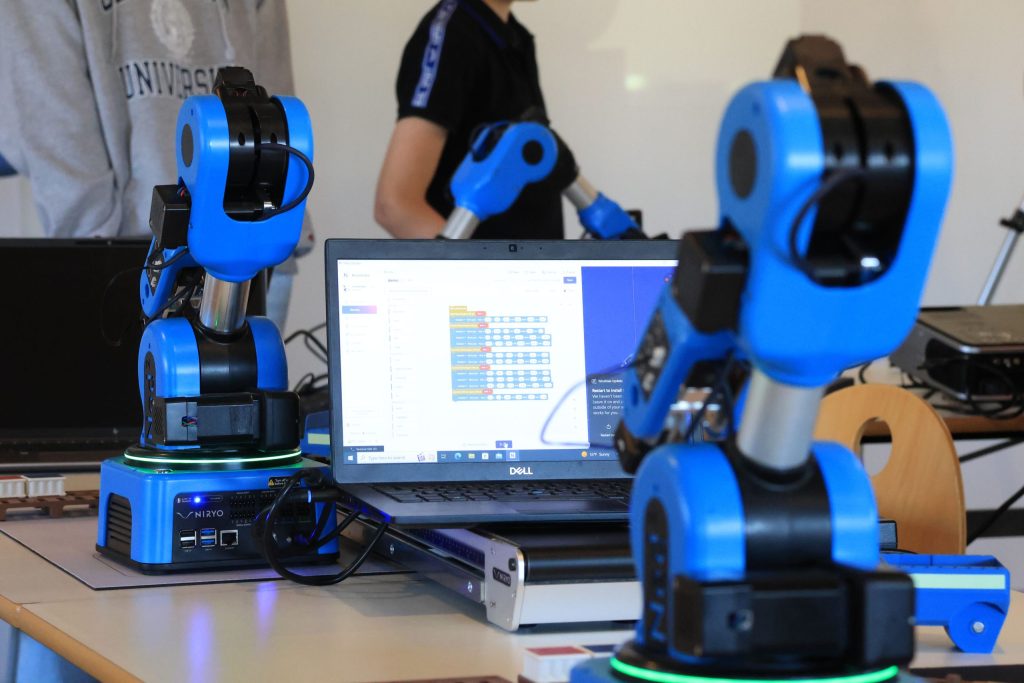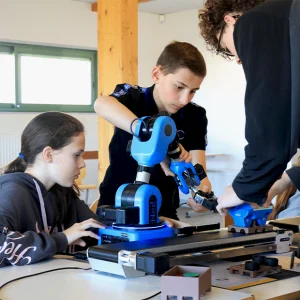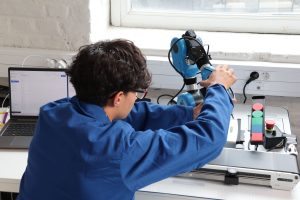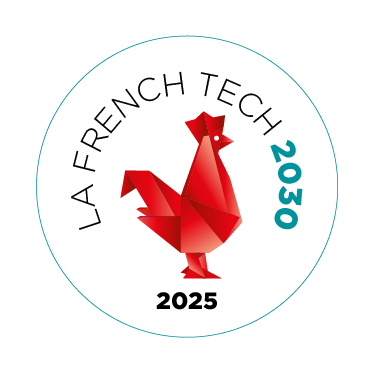Once confined to science fiction, robotics education is now ubiquitous in industry and beyond. How do these complex machines perform tasks with such precision and repeatability?
According to a recent study, the global robotic arm market is expected to reach $15 billion by 2028, highlighting their growing importance. The backbone of automation, robotic arms enable robots to perform complex tasks with precision, speed, and repeatability. Understanding how they work requires grasping their anatomy, consisting of joints, actuators, and sensors, as well as fundamental theories of motion, such as kinematics and dynamics.
This article delves into these concepts, with a particular focus on programming and trajectory planning, which are crucial for industrial and educational applications. Through concrete examples and modern teaching tools, students and teachers will learn how to master these systems to meet the technological challenges of a constantly changing world.
The anatomy of a robotic arm: key components
Robotics is a fascinating field, particularly in education, where robots provide an excellent teaching and training tool for young people.
At the heart of every robotic arm is the manipulator, which consists of a set of axes and joints. These joints can be rotary, like hinges, or prismatic, allowing linear movement. The number of axes, which is often synonymous with degrees of freedom, determines the robot’s flexibility. Some systems even feature redundancy for greater agility. Students who want to program a robot must understand how it works.
Movement is provided by actuators, which are mainly electric, hydraulic, or pneumatic motors. Combined with gearboxes, these motors provide the necessary torque and precision. Sensors, such as encoders, are often integrated into the actuators to allow for precise control. This enables teachers to use these tools in educational activities and classroom projects.
The theory of motion: kinematics and dynamics
Robotic motion theory is a fundamental field that explores how robots move. It is based on kinematics, which is the study of motion without considering forces, and dynamics, which analyzes the forces and torques responsible for motion.
Forward kinematics: predicting position
In robotics, forward kinematics is essential for understanding how a robot positions itself. It involves calculating the position and orientation of the robot’s end effector based on the angles of its various joints. Tools such as homogeneous transformation matrices are used to model each segment of the robot and its relationship to the others. This approach is essential for precisely programming robots.
Inverse kinematics: reaching a target
Inverse kinematics is often a more complex challenge. The goal here is to determine the angles of each joint so that the robot’s effector reaches a specific position and orientation. Unlike forward kinematics, there may be several possible solutions, or none at all, which makes it more difficult to solve and crucial for practical robot applications in industry or education.
Dynamics: forces and movements
In robotics, dynamics studies the forces and torques required to generate a desired movement. This knowledge is vital for sizing actuators, which are the motors that drive the robot, and for controlling the system’s inertia. Understanding dynamics enables engineers to design more efficient, stable robots with advanced technology for student projects in France.
Trajectory planning
Trajectory planning is the process by which a robotic arm determines the optimal path between two points. This includes calculating the shortest path and avoiding obstacles while optimizing for criteria such as time, energy, and smoothness of movement. Educational programs teach this skill so young people can learn to program and master these essential tools. It is a key skill for working with robots.
Perception and interaction: the senses of the robotic arm
Robotic arms rely on a variety of sensors that act as their eyes and touch. These essential tools include position, force, and vision sensors. They are crucial to modern robotics. They enable precise and safe interaction with the environment, which is a fundamental technology for many projects.
Robotic vision transforms robots for learning into agile operators. With 2D and 3D cameras, robots can recognize and locate objects, even unstructured ones, for sophisticated programming. These advances improve training and learning for young people, particularly in schools and colleges where educational kits, such as those by Lego, are used to teach programming.
Haptic and force feedback allow for delicate manipulation. Force/torque sensors allow robots to adapt and interact safely, which is an essential skill in science education. Artificial intelligence and machine learning optimize robot autonomy. AI, for example, enables adaptive grasping, which is crucial for educational activities and classroom projects and prepares students for the digital world of work.
Robotic arms can be programmed in various ways: teach pendants for direct learning, offline programming for simulation, or with graphical interfaces or specific languages. These tools are essential for teaching robotics to students and young people.
In industry, robots excel at welding, assembly, and palletizing, offering precision, consistency, and speed. Furthermore, these technologies are transforming surgery and logistics. Cobots (collaborative robots) represent a significant advancement by facilitating human-robot interaction and developing new skills.
Challenges include cost and flexibility, but the future promises more autonomous and intelligent robots. In France, schools and colleges are integrating these projects through educational kits, courses, and activities that teach digital skills and prepare children for tomorrow’s world via an innovative educational platform.
















